Related Research Articles
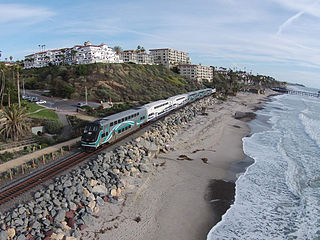
Metrolink is a commuter rail system in Southern California, serving Los Angeles, Orange, Riverside, San Bernardino, and Ventura counties, as well as to Oceanside in San Diego County. The system consists of eight lines and 69 stations operating on 545.6 miles (878.1 km) of track. Arrow is operated under a contract with the San Bernardino County Transportation Authority (SBCTA).

Los Angeles Union Station is the main train station in Los Angeles, California, and the largest passenger rail terminal in the Western United States. It opened in May 1939 as the Los Angeles Union Passenger Terminal, replacing La Grande Station and Central Station.

The Metrolink Ventura County Line is a commuter rail line serving Ventura County and the San Fernando Valley in Los Angeles County and the City of Los Angeles, in the Southern California system. The line is the successor of the short lived CalTrain commuter rail line.

Metrolink's Riverside Line is a commuter rail line running from L.A. Union Station in Downtown Los Angeles to Riverside along the Union Pacific Railroad. It runs weekday peak commuter hours only, with very little midday and reverse commute service. In 2011, the average weekday ridership was 5,161 passengers.
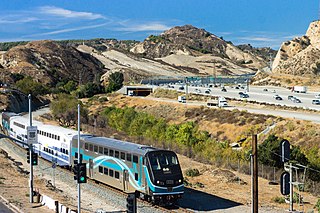
The Antelope Valley Line is a commuter rail line that serves the Northern Los Angeles County area as part of the Metrolink system. The northern segment of the line is rural in character because it travels through the sparsely populated Soledad Canyon between Santa Clarita and Palmdale, serving the small community of Acton along the way. Other portions of its route parallel the former US Route 6, now San Fernando Road and Sierra Highway. This is the only Metrolink line contained entirely within Los Angeles County.
The California Western Railroad, AKA Mendocino Railway, popularly called the Skunk Train, is a rail freight and heritage railroad transport railway in Mendocino County, California, United States, running from the railroad's headquarters in the coastal town of Fort Bragg to the interchange with the Northwestern Pacific Railroad at Willits.
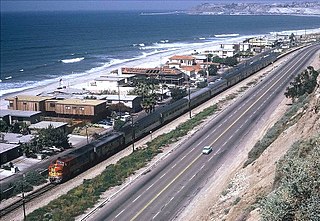
The Surf Line is a railroad line that runs from San Diego north to Orange County along California's Pacific Coast. It was so named because much of the line is near the Pacific Ocean, within less than 100 feet (30 m) in some places. The tracks are now owned by the Orange County Transportation Authority and the North County Transit District, and hosts Metrolink's Orange County Line and Inland Empire–Orange County Line, the San Diego Coaster, and Amtrak Pacific Surfliner passenger trains. The BNSF Railway operates freight over the line using trackage rights.

Sonoma–Marin Area Rail Transit (SMART) is a rail line and bicycle-pedestrian pathway project in Sonoma and Marin counties of the U.S. state of California. When completed, the entire system will serve a 70-mile (110 km) corridor between Cloverdale in northern Sonoma County and Larkspur Landing in Marin County. In 2022, the system had a ridership of 474,500, or about 2,700 per weekday as of the third quarter of 2023.
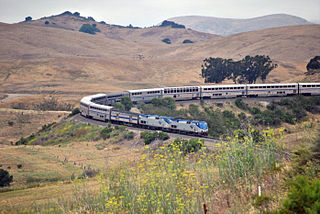
The Coast Line is a railroad line between Burbank, California and the San Francisco Bay Area, roughly along the Pacific Coast. It is the shortest rail route between Los Angeles and the Bay Area. Though not as busy as the Surf Line, the continuation of the Coast Line southbound to San Diego, it still sees lots of passenger trains, especially because of that of the Pacific Surfliner, which runs from the San Diego Santa Fe Depot to San Luis Obispo via Union Station in Los Angeles, is the third busiest Amtrak route outside of the Northeast Corridor between Washington D.C. and Boston, which in turn hosts two of Amtrak's busiest routes being the Acela and the Northeast Regional.

The Northwestern Pacific Railroad is a 271-mile (436 km) mainline railroad from the ferry connections in Sausalito north to Eureka with a connection to the national railroad system at Schellville. The railroad has gone through a history of different ownership and operators but has maintained a generic name of reference as The Northwestern Pacific Railroad, despite no longer being officially named that. Currently, only a 62-mile (100 km) stretch of mainline from Larkspur to the Sonoma County Airport in Windsor and east to Schellville on the “south end” is operated by Sonoma–Marin Area Rail Transit (SMART), which operates both commuter and freight trains with plans for future extension north to Cloverdale. The “north end” from Willits to Eureka is currently out of service, but saved by 2018 legislation to be converted into the Great Redwood Trail.

The Sierra Northern Railway is a common carrier railroad company operating in California. The company owns several rights of way originating from those of the former Sacramento Northern Railroad, Northern Electric Railway, Sierra Railway Company Of California, Western Pacific Railroad, and Yolo Shortline Railroad. It handles all freight operations and track maintenance for its parent company, the Sierra Railroad Company. The tracks that are maintained by Sierra Northern are also used by the Sierra Railroad Company's tourist trains.

Chatsworth station is an intermodal passenger transport station in the Los Angeles neighborhood of Chatsworth, United States. It is served by Amtrak inter-city rail service, Metrolink commuter rail service, Los Angeles Metro Busway bus rapid transit, and several transit bus operators.

The Fullerton Transportation Center is a passenger rail and bus station located in Fullerton, California, United States.
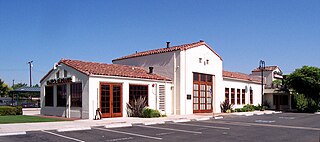
Orange station, formally the Orange Transportation Center, is an intermodal transit station in Orange, California. It serves Metrolink trains as well as Orange County Transportation Authority buses. The station is located at the site of two former Atchison, Topeka and Santa Fe Railway combination depots. The present depot structure was dedicated on May 1, 1938, and was closed with the Santa Fe's discontinuation of passenger service in 1971. The building was granted historic landmark status by the City on November 15, 1990.

Pomona–Downtown station, is a train station in Pomona, California, United States. It is primarily served by Metrolink’s Riverside Line commuter rail service, which runs between Los Angeles Union Station in the west and Riverside–Downtown station in the east. It is also less frequently serviced by two of Amtrak's long-distance inter-city rail services, the Sunset Limited, which runs between Union Station and New Orleans, Louisiana, and the Texas Eagle, which runs between Union Station and Chicago, Illinois, via Texas. It is owned and operated by the city of Pomona.

Positive train control (PTC) is a family of automatic train protection systems deployed in the United States. Most of the United States' national rail network mileage has a form of PTC. These systems are generally designed to check that trains are moving safely and to stop them when they are not.
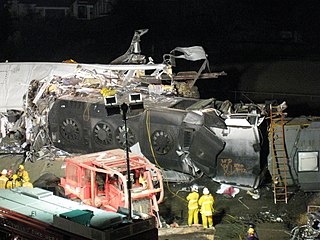
The 2008 Chatsworth train collision occurred at 4:22:23 p.m. PDT on September 12, 2008, when a Union Pacific Railroad freight train and a Metrolink commuter rail train collided head-on in the Chatsworth neighborhood of Los Angeles, California, United States.
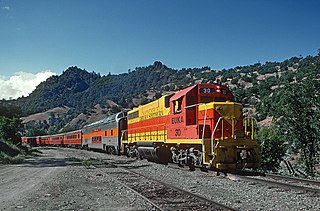
The Eureka Southern Railroad was a shortline freight and excursion railroad that ran over former Northwestern Pacific trackage in California from Willits to Eureka.
References
- ↑ "Glossary" (PDF). archives.gov. Retrieved June 13, 2020.
- ↑ "Pricing and tools" (PDF). bnsf.com. Retrieved June 13, 2020.
- ↑ "Embargo". OmniTRAX. Retrieved June 13, 2020.
- ↑ "Statutes" (PDF). legislature.maine.gov. Retrieved June 13, 2020.
- ↑ "Guide for Railroads" (PDF). public.railinc.com. January 2018. Retrieved June 13, 2020.
- ↑ "Excerpts from MCRS newsletters, December 1988 to July 2004". Mendocino County Railway Society. Retrieved June 13, 2020– via North Coast Railroad Authority.
- ↑ "Feds can inspect repairs". petaluma360.com. Retrieved June 13, 2020.
- ↑ Leahy, Arthur T. (September 14, 2015). "Letter to John Thune, Chairman, Committee on Commerce, Science and Transportation, United States Senate from Southern California Regional Rail Authority (Metrolink)". commerce.senate.gov. Retrieved June 13, 2020.
- ↑ "DeFazio Testifies Before the Surface Transportation Board". Congressman Peter DeFazio. April 24, 2008. Retrieved June 13, 2020.
- ↑ "Rail line agreement reached". tabor-loris.com. Retrieved June 13, 2020.
- ↑ Stephens, Bill (December 13, 2022). "Shippers, labor, and regulators critical of Union Pacific's use of embargoes". Trains . Kalmbach Media. Archived from the original on December 21, 2022. Retrieved December 21, 2022.